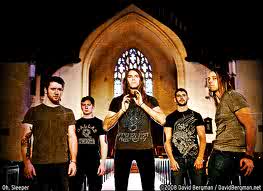 As mentioned in our last editorial Covering The Scene: Hardcore, a natural progression began to happen in 1997. For so long the metal and hardcore scenes were separate, with a degree of animosity from fans of one genre toward the other. During the late ’80’s that began to change as thrash metal bands began to experiment with hardcore and vice verses, but it wasn’t until a decade later that this sound became an actual scene.
As mentioned in our last editorial Covering The Scene: Hardcore, a natural progression began to happen in 1997. For so long the metal and hardcore scenes were separate, with a degree of animosity from fans of one genre toward the other. During the late ’80’s that began to change as thrash metal bands began to experiment with hardcore and vice verses, but it wasn’t until a decade later that this sound became an actual scene.
In the christian scene spirit-filled hardcore reigned supreme with bands such as Strongarm, Overcome, Zao, Focused, and Unashamed leading the pack. In 1997 a musical shift in the scene began, seemingly on one release. Arkansas metal veterans Living Sacrifice released their now legendary album Reborn. On Reborn, Living Sacrifice did away with most of the death and thrash metal sound that was performed on their earlier albums. In it’s place was a nice blend of thrash metal, death metal, and hardcore. The album also featured an industrial edge where tape loops were evident.
Saying the scene turned on one album wouldn’t be totally accurate as Zao and Overcome added a strong metal influence to their spirit-filled hardcore sound. The following year (1998) this new sound, known as metalcore, would replace spirit-filled hardcore as the sound of the underground, due to monumental releases by Training For Utopia, Embodyment, and Zao.
Each of the following releases have proved extremely influential in the years that have followed.
1.) On their debut full-length Plastic Soul Impalement, Training For Utopia created a noisy, chaotic combination of metallic heaviness and hardcore fury. This album was the first “noise-core” or “chaos-core” album to hit the christian music scene.
2.) With their Solid State Records debut, Embracing The Eternal, Ft. Worth area death metal band Embodyment added a hardcore edge to their metal rage, creating one of the first deathcore albums.
3.) With their next release, Where Blood and Fire Bring Rest, Zao took the metal influence that was evident on their last album, 1997’s The Splinter Shards The Birth Of Separation and made that the foundation of the album. The new album was both more artistic, yet heavier than it’s predecessor. New vocalist Dan Weydandt brought a sharper, serpentine style of vocals in comparison to the hardcore shouts and screams of Shawn Jonas. This album along with Living Sacrifice’s Reborn was the game-changer in the scene.
The following three years brought an explosion of solid releases from bands such as Spitfire, Society’s Finest, Luti-Kriss, Nodes Of Ranvier, Warlord, and As I Lay Dying as well as great new albums from Living Sacrifice and Zao, further establishing their credibility. In 2002 an odd thing started happening. The scene splintered off into two completely different directions. In one direction, we had chaotic metalcore with it’s dark, angular, disjointed guitar riffs. The most notable release being Norma Jean’s (formerly Luti-Kriss) amazingly complex, yet simple chaos-core opus Bless The Martyr Kiss The Child. In the other direction we had bands like Killswitch Engage, whom popularized a more melodic form of metalcore, which featured clean singing on the chorus’ and melodic, harmonized guitar leads and solos.
As the new decade came to it’s half-way point, metalcore began to receive popularity in the mainstream due to it’s more melodic performers as bands such as Killswitch Engage and As I Lay Dying began to cross-over into the mainstream metal world and even into the MTV crowd. As the mainstream become more enamored with metalcore, the scene it came from began to get bored, and in search of something else. Enter deathcore.
By 2007 the market had become so saturated with metalcore releases, that finding an album or band that stood out from the crowd was difficult. A scene began to form in the underground metal world that would bring a raw sense of brutality and heaviness to the mainstream. Deathcore melded the brutality of death metal with constant, crushing breakdowns. While fresh at first, by 2009 deathcore had become as tired as metalcore, due to it’s complete lack of range in both songwriting and performance.
As stagnate as things had become, 2010 and 2011 featured plenty of very well written and well performed albums in the metalcore scene. Bands such as Living Sacrifice, Haste The Day, The Chariot, As I Lay Dying, Norma Jean, Demon Hunter, Oh Sleeper (pictured), Underoath, and A Plea For Purging proved that when done right, metalcore could still be an exciting genre. This factor along with the sudden resurgence of hardcore, and the solid pure death metal albums being released has brought a balance to the scene that hasn’t been seen since the early days of the genre.